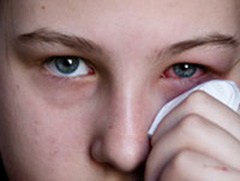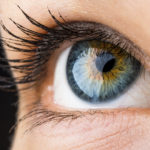Conjunctivitis

What is conjunctivitis?
Conjunctivitis is an irritation of the conjunctiva, a membrane that lines the inside of the eyelids and covers the whites of the eyes. The common terms, "pink eye," and "red eye" refer to the pink or red cast of the whites of the eyes caused by the inflammation of small blood vessels.
What are the symptoms of conjunctivitis?
The symptoms are redness in the whites of one or both eyes or inner eyelids, itching, irritation and excessive tearing. Your vision may be blurred and you may be sensitive to light. Your eyes may feel gritty, and there may be a discharge in one or both eyes that forms a crust during the night.
What are the causes?
Sometimes conjunctivitis occurs as an allergic reaction to pollen, dust or other foreign material in the eye – such as contact lens solution. When this is the case, the itching and irritation may be severe, the eyes may be very watery and even painful. Sometimes ordinary household chemicals and personal-care items such as spray perfumes and deodorants cause the irritation.
Conjunctivitis can also be due to a bacterial infection. This is more common among children than it is among adults and often is associated with a cold or sore throat. With bacterial infections, both eyes usually are affected, and you may notice a thick yellow discharge crusting over the eyelashes, especially when you wake up in the morning.
Finally, conjunctivitis can be caused by viruses, particularly those associated with colds as well as measles and other childhood illnesses. Viral conjunctivitis is very common. Onset is abrupt and usually in one eye, with the other eye becoming infected a day or two later. Excessive tearing and redness without pus-filled discharge are the usual symptoms.
What is the conventional treatment of conjunctivitis?
If the cause is known to be a chemical of any type that has gotten into the eye, flush the eye with water and call your physician. If a child gets a chemical product into his or her eye, follow the medical advice given on the package, go to the nearest hospital emergency room and be sure to tell the doctors what the substance was.
Bacterial conjunctivitis usually is treated with antibiotic eye drops or ointment but is contagious as long as there is discharge from the eye. Viral conjunctivitis usually clears up on its own within a week and is contagious while symptoms last. To avoid spreading the infections, don’t share towels, cups or drinking glasses; wash your hands after applying eye drops or ointment to your eyes (or your child’s eye); and don’t use eye drops in a non-infected eye that were used in an infected one. Also, don’t send children with viral or bacterial conjunctivitis back to school or day care until they are no longer contagious.
To relieve any discomfort of pink eye, apply warm compresses (use a clean, link-free cloth soaked in warm water and wrung out) to closed eyelids. Use cool compresses for allergic conjunctivitis and avoid rubbing your eyes. Over-the-counter eyedrops such as Naphcon-A or Opcon-A, which contain an antihistamine and an agent that constricts blood vessels may help.
To avoid reinfection don’t touch your eyes with your hands, wash your hands often (and thoroughly), change your towel and washcloth daily and make sure that no one else uses them, change your pillowcase often, throw away eye makeup (particularly mascara) and don’t use anyone else’s eye makeup or any type of cosmetic or skin care item that touches the face.
What therapies does Dr. Weil recommend?
Follow conventional medical advice for treating conjunctivitis and take the precautions recommended in the section above to avoid spreading the infection.









